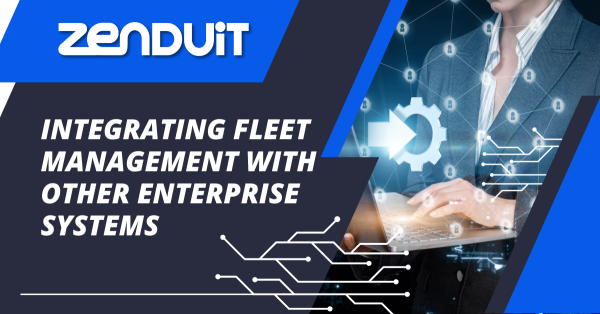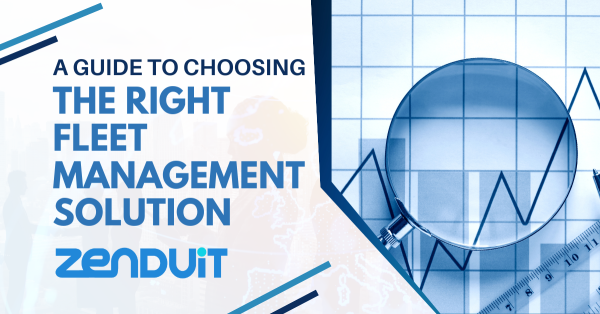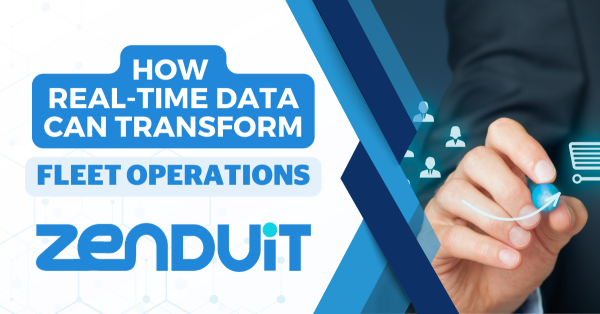Integrating Fleet Management with Other Enterprise Systems
November 13, 2023
Fleet management is a critical function in businesses that rely on transportation for their operations. It encompasses all aspects of managing a company’s vehicle fleet, from acquisition and maintenance to tracking and disposal.
This process involves a variety of tasks such as vehicle financing, maintenance, tracking and diagnostics, driver management, fuel management, and health and safety management. The goal of fleet management is to improve efficiency, reduce costs, and ensure compliance with government regulations.
With the advancement of technology, fleet management has evolved to include sophisticated software and systems, enabling better tracking and management of vehicles.
Integrating fleet management with other enterprise systems like Enterprise Resource Planning (ERP), Customer Relationship Management (CRM), and Human Resources (HR) systems can significantly enhance operational efficiency. This integration facilitates seamless data flow and communication between different departments, leading to better resource allocation, improved data accuracy, and more informed decision-making.
For instance, integrating fleet data with ERP systems can provide real-time insights into logistics, which helps in optimizing routes and reducing fuel costs. Similarly, syncing fleet management with HR systems can streamline driver management processes like scheduling, training, and compliance. The holistic view provided by this integration is crucial for strategic planning and overall organizational effectiveness.
This article provides a comprehensive understanding of how integrating fleet management with other enterprise systems can transform and streamline business operations. It will explore the nuances of enterprise systems and explore the fundamentals of fleet management. The subsequent sections will discuss the benefits and strategies of integration, backed by real-world case studies and success stories.
In addition, the article will address common challenges in integration and offer solutions, while also casting a forward-looking view on the future trends in fleet management technology.
![]()
Understanding Enterprise Systems
Enterprise systems refer to large-scale software applications designed to operate in a corporate environment. These systems are used for managing and automating core business processes across an organization, ensuring that information flows smoothly through different departments. There are several types of enterprise systems, each serving a distinct purpose:
- Enterprise Resource Planning (ERP) systems integrate all facets of an operation, including product planning, development, manufacturing processes, sales, and marketing.
- Customer Relationship Management (CRM) systems help manage a company’s interactions with current and potential customers, focusing on customer retention and driving sales growth.
- Supply Chain Management (SCM) systems are used for overseeing and managing the flow of goods and services, including all processes that transform raw materials into final products.
- Human Resources Management Systems (HRMS) support the HR department in managing people, policies, and procedures.
- Business Intelligence (BI) systems analyze complex data to help in decision-making.
- Content Management Systems (CMS) are used for managing digital content.
The Role of Enterprise Systems in Modern Business
Enterprise systems play a pivotal role in modern business. They enable organizations to manage their operations with greater efficiency and effectiveness. Key roles include:
- Integration of Business Processes: By bringing disparate business processes under one umbrella, these systems ensure seamless data flow and coordination between different departments.
- Improved Decision Making: With real-time data analysis and reporting capabilities, enterprise systems facilitate informed decision-making.
- Increased Efficiency: Automation of routine tasks reduces errors and saves time, leading to enhanced operational efficiency.
- Scalability and Flexibility: They provide the scalability and flexibility needed to adapt to changing business environments and market demands.
- Data Consistency and Quality: Centralized data management helps in maintaining data consistency and quality across the organization.
Examples of Common Enterprise Systems
These systems, when effectively implemented, not only streamline individual business functions but also offer a synergistic effect that can significantly boost overall organizational performance. Integrating such systems with specialized tools like fleet management systems can further enhance this effect, leading to more efficient and effective business operations. Common examples of enterprise systems include:
- SAP ERP: A comprehensive ERP solution offering modules for finance, HR, supply chain, and more.
- Salesforce CRM: A popular CRM platform known for its customer engagement tools and analytics.
- Oracle SCM Cloud: A solution for supply chain management, offering features like supply chain planning, procurement, and logistics.
- Workday HRMS: A widely used HRMS platform for human capital management, payroll, and financial management.
- Microsoft Power BI: A BI tool for data analysis and sharing insights across an organization.
- WordPress: A versatile CMS used for website creation and digital content management.
Fleet Management Basics
Fleet management is the administrative approach used by organizations to manage and coordinate their vehicle fleet. This includes a wide range of functions, such as vehicle financing, maintenance, telematics (tracking and diagnostics), driver management, speed management, fuel management, health and safety management, and vehicle tracking. The primary aim of fleet management is to improve efficiency, reduce costs, and provide compliance with government regulations. In essence, it’s about overseeing all fleet performance and vehicle maintenance to increase productivity and ensure that the business operates a safe, efficient, and cost-effective fleet.
Key Components of Fleet Management Systems
- Vehicle Tracking: Utilizes GPS technology to monitor the location, movement, and behavior of a vehicle.
- Vehicle Maintenance: Schedules, tracks, and manages the repair and maintenance of vehicles to ensure they are safe and operational.
- Fuel Management: Monitors and manages fuel usage and efficiency, which is a major cost factor in fleet operations.
- Driver Management: Includes monitoring driver behavior, scheduling training programs, and ensuring compliance with safety standards.
- Compliance Management: Ensures that all vehicles and operations comply with regional and national regulations.
- Cost Management: Focuses on reducing various costs associated with vehicle operation, including fuel, maintenance, and insurance.
- Data Analysis and Reporting: Systems provide data analysis tools for fleet performance assessment and facilitate strategic decision-making.
Challenges in Fleet Management
Understanding these basics of fleet management is crucial to appreciate how its integration with other enterprise systems can lead to significantly improved business operations. This integration can help in addressing many of the challenges by providing a more unified, efficient, and data-driven approach to fleet management:
- Cost Control: Managing the rising costs of fuel, maintenance, and insurance is a constant challenge in fleet management.
- Compliance with Regulations: Staying up-to-date with changing regulations and ensuring compliance is complex and requires continuous attention.
- Vehicle Maintenance: Keeping a fleet in optimal condition requires an efficient maintenance strategy and can be resource-intensive.
- Optimizing Fleet Operations: Continuously seeking ways to increase efficiency and productivity, such as route optimization and driver performance monitoring.
- Data Overload: With the advent of telematics and IoT, managing and interpreting vast amounts of data can be overwhelming.
- Safety and Security Concerns: Ensuring the safety of drivers and vehicles, along with the security of goods being transported.
- Environmental Concerns: Adapting to more environmentally friendly practices and technologies to reduce the fleet’s carbon footprint.

The Need for Integration
Integrating fleet management with other enterprise systems offers numerous benefits that can substantially enhance business operations:
- Improved Data Accuracy and Accessibility: By connecting fleet data with other systems, businesses ensure data accuracy and accessibility, reducing errors and duplications.
- Enhanced Collaboration and Communication: Integration fosters improved communication between departments such as logistics, finance, and HR, facilitating better teamwork and decision-making.
- Cost Reduction and Efficiency: Integrated systems help identify areas of cost reduction (like fuel consumption, maintenance costs) and enhance overall operational efficiency.
- Real-Time Insights and Proactive Management: Integration enables real-time tracking and analytics, allowing for proactive management of fleet operations.
- Automated Workflows and Reduced Paperwork: Automated data exchange between systems reduces manual data entry and paperwork, leading to time savings and reduced human errors.
- Regulatory Compliance and Reporting: Easier compliance with regulatory requirements through streamlined reporting and data management.
Streamlining Operations and Data Flow
The integration of fleet management systems with other enterprise systems streamlines operations and data flow in several ways:
- Seamless Information Sharing: Critical information like vehicle availability, maintenance schedules, and driver assignments can be shared seamlessly across different departments.
- Integrated Logistics and Supply Chain: Fleet data integrated with supply chain systems can optimize delivery routes, improving logistics efficiency.
- Unified Dashboard and Control: A centralized dashboard that combines fleet data with other business metrics offers a holistic view of operations.
- Synchronized Scheduling and Planning: Integration allows for better scheduling and planning by aligning fleet availability with business demands and employee schedules.
Enhancing Decision Making and Efficiency
Integrating fleet management systems with other enterprise systems enhances decision-making and operational efficiency in several aspects:
- Data-Driven Decisions: Access to comprehensive data across systems aids in making informed, data-driven decisions.
- Predictive Analytics and Forecasting: Advanced analytics can predict maintenance needs and optimize fleet utilization, leading to better resource planning.
- Increased Responsiveness: Integration enables businesses to respond more quickly to changing conditions, like adjusting routes in real-time based on traffic data.
- Optimized Resource Allocation: Better data and analysis lead to optimized allocation of vehicles and drivers, reducing idle time and increasing productivity.
The integration of fleet management with other enterprise systems is not just beneficial but essential in today’s fast-paced and data-driven business environment. It leads to more streamlined, efficient, and effective operations, supporting better decision-making and ultimately contributing to the overall success and competitiveness of the business.
Integration Strategies
To effectively integrate fleet management with other enterprise systems, it’s crucial to identify key integration points:
- Accounting and Finance: Integration with accounting systems ensures accurate and timely financial reporting, budgeting, and cost management related to fleet operations.
- Human Resources (HR): Syncing with HR systems can streamline driver management processes such as payroll, scheduling, training, and compliance with safety standards.
- Logistics and Supply Chain Management: Integrating fleet data with logistics systems can optimize route planning, delivery schedules, and inventory management.
- Customer Relationship Management (CRM): This helps in aligning fleet operations with customer needs and expectations, improving service delivery and customer satisfaction.
- Maintenance and Procurement: Integration with maintenance and procurement systems can automate the scheduling of vehicle repairs and the ordering of parts, enhancing fleet uptime.
Choosing the Right Technology and Platforms
Selecting the appropriate technology and platforms is critical for successful integration:
- Compatibility and Scalability: Ensure that the chosen technology is compatible with existing systems and can scale as the business grows.
- User-Friendly Interface: Systems should have an intuitive interface for ease of use and adoption by staff.
- Data Security and Compliance: Choose platforms that offer robust data security features and comply with relevant data protection regulations.
- Customization and Flexibility: Systems that allow customization can be tailored to meet the unique needs of your business.
- Support and Training: Opt for vendors that provide reliable support and training resources to facilitate smooth implementation and adoption.
Best Practices for Seamless Integration
Implementing best practices can significantly enhance the success of integration efforts:
- Clear Goals and Objectives: Define clear goals for what the integration should achieve, aligning them with overall business objectives.
- Stakeholder Engagement: Involve all key stakeholders from the beginning to ensure their needs are met and to gain their support.
- Phased Implementation: Roll out the integration in phases to manage risks and allow for adjustments based on feedback.
- Data Management and Quality: Establish protocols for data management to ensure the integrity and quality of the data being shared across systems.
- Continuous Monitoring and Improvement: Regularly monitor the integration process for any issues and continually seek opportunities for improvement.
- Change Management: Implement a change management strategy to help staff adapt to new systems and processes.
By carefully planning and executing these integration strategies, organizations can ensure that their fleet management systems work in harmony with other enterprise systems, leading to enhanced efficiency, better decision-making, and improved overall business performance.
Case Studies and Success Stories
The following case studies underscore the transformative impact that integrating fleet management with other enterprise systems can have on an organization’s efficiency, cost-effectiveness, and overall business performance.
Examples of Successful Integration
- Cox Enterprises: Cox Enterprises, a large organization with a fleet of over 13,000 assets, faced challenges in consolidating fleet data across multiple businesses. By integrating and automating its data into a central management information system, Cox Enterprises achieved increased operational and cost control. This integration provided increased fleet asset utilization visibility, improved cost visibility, and enhanced compliance while reducing administrative burdens. It also allowed for real-time access to enterprise-wide fleet-related data and support.
- Microsoft: At Microsoft’s Redmond campus, the management of a sizable transportation fleet was unified using a connected vehicle solution. This integration was aimed at understanding fleet capacity, reacting to demand, optimizing routes, and intelligently maintaining their fleet of over 500 vehicles. The solution provided real-time information for every aspect of fleet management, improved fuel efficiency, and lowered emissions, aligning with Microsoft’s sustainability goals.
- Adapt Integrated Health Care: This nonprofit organization, providing healthcare services in southwest Oregon, transformed its fleet management. Previously reliant on an error-prone Excel spreadsheet for vehicle tracking and key management, the integration led to significant improvements in fleet operations. The organization streamlined vehicle allocation processes, improved the efficiency of their 85-vehicle fleet, and supported their mission more effectively, avoiding the need for a 55% larger fleet.
Overcoming Integration Challenges
Successfully navigating integration challenges requires a strategic approach that emphasizes careful planning, effective communication, and a focus on change management. By adopting these strategies, organizations can significantly enhance the likelihood of successful integration, leading to improved efficiency and business performance.
Common Pitfalls in Integration Projects
- Inadequate Planning and Analysis: Failing to thoroughly analyze business needs and system requirements can lead to mismatched integrations.
- Poor Data Management: Inconsistent or poor-quality data can undermine the effectiveness of the integration.
- Underestimating Resource Requirements: Insufficient allocation of resources, including time, budget, and personnel, can impede successful integration.
- Resistance to Change: Employees may resist new systems and processes, hindering effective implementation.
- Lack of Proper Communication: Ineffective communication among teams can cause misunderstandings and delays.
- Technology Compatibility Issues: Compatibility problems between new and existing systems can create significant technical challenges.
Solutions and Mitigation Strategies
- Comprehensive Planning: Conduct thorough planning and requirement analysis to align the integration with business goals.
- Data Quality Management: Implement robust data management practices to ensure data accuracy and consistency.
- Realistic Resource Allocation: Allocate adequate resources and consider unforeseen contingencies in the project planning.
- Effective Communication: Maintain open and consistent communication across all levels of the organization.
- Technology Assessment: Conduct thorough compatibility checks and technology assessments before integration.
- Pilot Testing: Conduct pilot tests to identify and address issues before full-scale implementation.
Change Management and Employee Training
- Stakeholder Engagement: Engage stakeholders early in the process to understand their needs and concerns.
- Change Advocates: Identify and train change advocates or champions within the organization to facilitate the transition.
- Employee Training: Provide comprehensive training to employees on new systems and processes.
- Feedback Mechanism: Establish a feedback mechanism to continuously gather and address employee concerns and suggestions.
- Continuous Communication: Keep employees informed about the progress and benefits of the integration project.
- Cultural Adaptation: Foster a culture that embraces change and innovation.
Final Thoughts
Integrating fleet management with other enterprise systems is not just an operational upgrade; it’s a strategic move. It streamlines operations, enhances data flow, improves decision-making, and ultimately contributes to the overall success and competitiveness of the business. This integration is a critical step in adapting to the fast-evolving business landscape and leveraging technology for maximum efficiency and effectiveness.
Contact your ZenduiT consultant to unlock the full potential of your fleet operations, drive innovation, and maintain a competitive edge.


